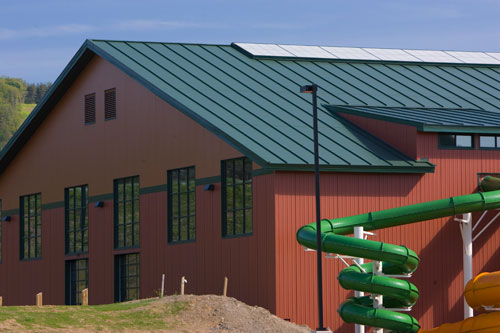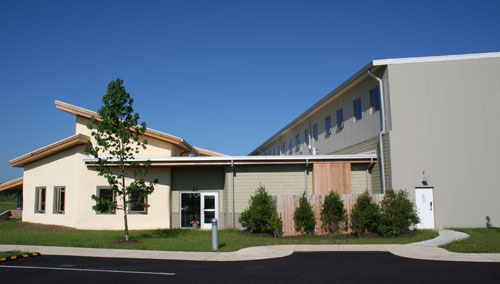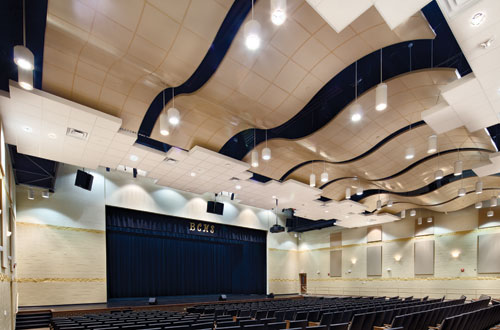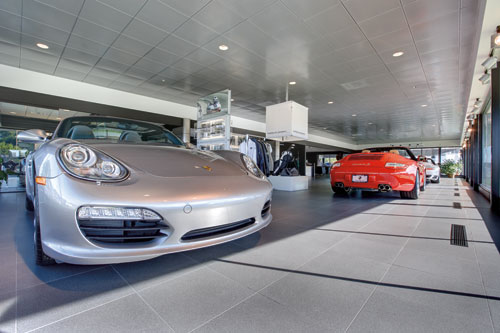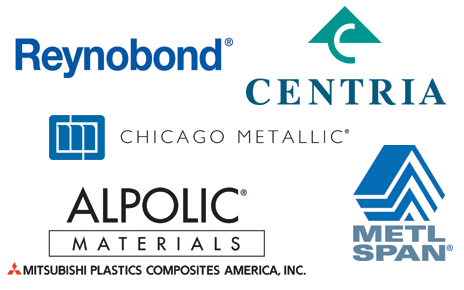Innovative Metal Solutions for the Built Environment
High-performance metal products achieve sustainable, cost-effective results
![]() Continuing Education
Continuing Education
Use the following learning objectives to focus your study while reading this month’s Continuing Education article.
Learning Objectives - After reading this article, you will be able to:
- Analyze how titanium dioxide coil-coated aluminum architectural panels can clean buildings and improve air quality, while reducing building maintenance costs.
- Evaluate the impact of building codes, acoustics, corrosion, and materials when specifying metal ceiling systems.
- Describe the long-term benefits of using metal panel roofing systems with photovoltaic solar arrays.
- Explain how insulated metal wall and roofing panel systems lower building energy costs and improve thermal comfort of building occupants.
From exterior building envelope walls and roofing to interior ceiling systems, metal offers a variety of innovative products, composites, and sustainable design solutions suitable for any climate and building type. Extensive building industry research has led to exciting new products and advanced proven technologies that define building industry standards.
The word metal is derived from the Ancient Greek metallon, and the Latin metallum, for “mine, quarry, mineral.” Metal is an element, compound, or alloy that is a good conductor of electricity and heat. As building components, metals offer many desirable qualities, especially in combination with other building components. Metals are usually malleable, formable, and can be hammered or pressed permanently out of shape without breaking or cracking. They are durable, ductile, shiny, and therefore reflect most incident light. Metals provide insulation, are highly recyclable, and sustainable. Metals are compatible with paints and coatings, and available in finishes and colors to meet any design requirement.
Self-cleaning buildings were unheard of a few years ago but they are now keeping skylines and outdoor air cleaner. Insulated metal wall and roofing panels are proven, energy-efficient systems that are constantly updated and refined to meet emerging technology, building codes, sustainability, and project needs. Metal ceiling systems have a wide range of features and design flexibility to bring visionary concepts to reality, while meeting code requirements.
Reputable U.S. building product manufacturers comply with a multitude of American building codes and performance standards. Many use independent physical testing programs to meet and exceed code requirements on issues such as water penetration, uplift ratings, fire protection, seismic and structural performance. When specifying metal products and panels, architects should verify if products have undergone rigorous testing in the U.S. to ensure reliable performance. Building materials and products are often tested and certified against standards by recognized research organizations such as the American Society for Testing and Materials (ASTM), Underwriters Laboratories (UL), and Factory Mutual (FM).
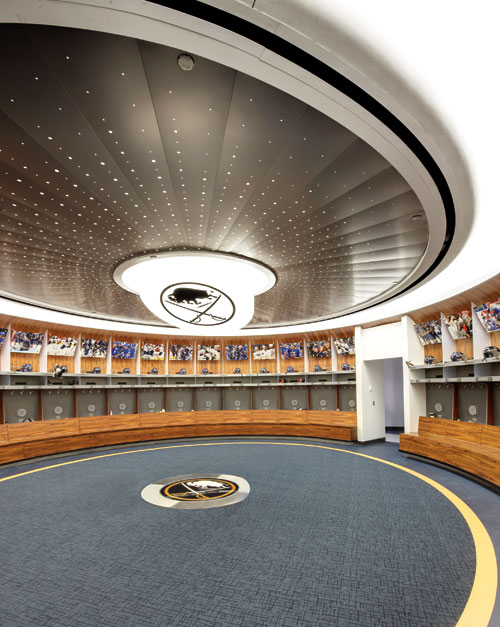 |
This custom metal ceiling in the Buffalo Sabres' hockey team dressing room at the First Niagara Center, Buffalo, New York, was inspired by the ice and steel blades. Architect: Cannon Design. Photo by Bochsler Creative Solutions, Burlington, ON; courtesy of Chicago Metallic |
Industry Trends
 |
An insulated metal panel system at Pacific Plaza, Tacoma, Washington, provides an air and vapor barrier. Architect: BLRB Architects. Photo courtesy of Metl-Span |
According to George Rosado, commercial director for Alcoa Architectural Products, “Emerging trends indicate an increasing number of imported metal products. However, using them involves great risk, because there is no control over whether these imports will meet North American building codes and industry standards.” U.S. contractors have no control over what actually gets shipped, and whether appropriate testing and verification is even available on imported materials. If an imported material fails to perform, contacting an overseas manufacturer for replacement may be problematic. The risk can be significant, when the effects of failure, lost downtime, replacement, bonding, and insurance are considered.
Metal ceilings for commercial applications are gaining in popularity in the U.S. after decades of use as building standards in Europe. Public structures such as airports, subways, universities, and office buildings are benefiting from the durability and accessibility of metal ceilings. These applications illustrate the variety of finishes available on metal ceilings, says Edward Williams, business unit manager for metal ceilings at Chicago Metallic.
“Insulated metal panels (IMPs) are highly efficient building envelope products with multiple benefits. Their high R-values and insulating qualities lower heating and cooling costs year-round. IMPs contribute significantly to sustainability and LEED points,” says Doug Pickens, vice president of marketing, Metl-Span.
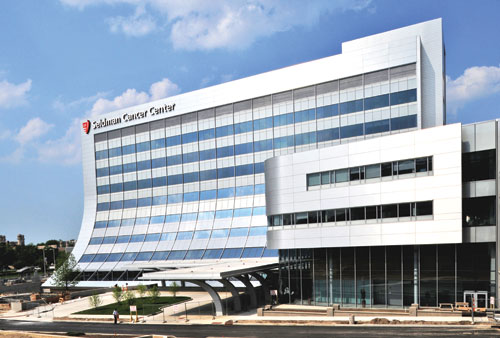 |
The 10-story, 375,000-square-foot Seidman Cancer Center in Cleveland, Ohio, features 59,000 square feet of brushed aluminum composite material on the exterior and the interior building fascia, soffits, and parapet panels. Architect: Cannon Design. Photo by Mark Kempf Photography; courtesy of Alcoa Architectural Products |
Self-Cleaning Buildings
Aluminum is the most abundant metal in the earth's crust, comprising about 8 percent by weight of the earth's solid surface. Aluminum is silvery white, insoluble in water under normal circumstances, and is known for its ability to resist corrosion. Structural components made from aluminum and its alloys are vital to the building, transportation, and aerospace industries. Due to its infinite recyclability, aluminum could be considered a manufactured natural resource. At present, almost 75 percent of all the primary aluminum ever produced since 1888 is still in productive use today.
Aluminum composite material is a composite panel consisting of an extruded thermoplastic compound core that is fusion-bonded in a continuous process between two sheets of coil-coated aluminum, brushed aluminum, zinc, stainless steel, titanium, or copper. The result is a highly corrosion-resistant, rigid, flexible material that weighs 3.4 times less than steel and 1.6 times less than pure aluminum.
Aluminum composite panels are flat, malleable, lightweight, durable, and can be painted in a range of colors and finishes with exterior warranties up to 30 years. They integrate easily with most curtain walls, creating a seamless look on building facades. This highly formable material can be used to create curves and design accents.
A new technology is available to assist building owners and architects in addressing building maintenance. An innovative coating, when applied to aluminum composite materials, can help buildings become self-cleaning. Research shows that titanium dioxide coil-coated aluminum architectural panels remove pollutants by using sunlight, water vapor, and oxygen in the air to clean the air around it. Titanium dioxide coil-coated aluminum architectural panels are appropriate for office buildings, retail facilities, car dealerships, chain restaurants, elementary schools, and other applications.
 |
The canopy at the Piedmont College Arrendale Amphitheater, Demorest, Georgia, was sculpted from aluminum composite material to reflect the natural environment bordering the site. Architect: Armentrout Roebuck Matheny Consulting Group. Photo by Mark Kempf Photography; courtesy of Alcoa Architectural Products |
Titanium Dioxide Coatings
Titanium dioxide is a widely used white compound known for its strong ultraviolet (UV) light-absorbing capabilities and its resistance to discoloration under UV light. In powder form, titanium dioxide is an effective pigment that provides whiteness and opacity to products such as paints, coatings, plastics, papers, inks, sunscreen, medicines, and toothpaste, as well as quick-setting concrete and tile grout. Titanium dioxide naturally attacks organic pigments in paint. An innovative titanium dioxide coil-coating process protects paint and enhances paint finish performance, while providing environmental and cleaning benefits. When combined with aluminum, the result is a process that could not occur with either material alone.
Titanium dioxide has two unique effects. If exposed to sunlight, titanium dioxide acts as a catalyst to break down organic matter, while also creating a superhydrophilic (water-loving) surface. When a titanium dioxide coating is applied to the pre-painted aluminum surface of a metal composite panel, the result is a coil-coated aluminum architectural panel that cleans itself and the air around it.
As a photocatalyst, titanium dioxide interacts with sunlight to break down organic matter on and around the surface of building panels, leaving organic matter on the surface of an aluminum composite panel ready to be washed away. When it rains, water doesn't bead on the surface, but instead runs evenly down the building, removing grime and pollutants.
Buildings are exposed to many organic contaminants. From bird residue to diesel fumes, architectural building panels are constantly exposed to organic material that makes these surfaces appear dirty.
Nitrogen oxide is an organic material constantly bombarding buildings that is harder to see. As the primary component of smog, nitrogen oxide makes buildings dirty and threatens the quality of outdoor air. When nitrogen oxide molecules float near the surface of titanium dioxide coil-coated aluminum architectural panels, they are attacked by free radicals generated from the titanium dioxide reacting with water and oxygen in the air. The free radicals oxidize the nitrogen oxide molecules, converting them into harmless nitrates. Other contaminants are similarly broken down through sunlight's reaction with titanium dioxide, leaving them ready to be washed away. Titanium dioxide coil-coated aluminum architectural panels effectively remove pollutants by using sunlight, water vapor, and oxygen to clean the air.
Once the titanium dioxide has done its job—broken down and destroyed the nitrogen oxide and other organic matter on the aluminum composite material—a second major benefit, creating a superhydrophilic surface, comes into play.
Because the titanium dioxide coil coating is superhydrophilic, the surface of aluminum composite materials becomes very slick in the presence of water. Instead of beading on the surface, rainwater runs evenly off the aluminum panels, taking most of the organic matter and nitrates with it. This helps eliminate the tiger-striped look that often appears on building surfaces around caulk joints, air ducts, and roof water discharge points. The slightest amount of rain or humidity in the air creates the effect; even morning dew activates the process. Each time it does, the water running off the building carries away broken-down contaminants, leaving the building surface cleaner.
Reduced Maintenance CostsBy constantly breaking down organic matter through its photocatalytic properties, and washing material away through its superhydrophilic properties, titanium dioxide coil-coated aluminum architectural panels can significantly reduce facility maintenance costs. This process helps maintain the building image and appearance over time as first requested by the owner and envisioned by the architect.
The primary indicator that a titanium dioxide coating is working effectively is the building appearance. When exposed to UV light, exterior building panels treated with titanium dioxide coating will be cleaner than those of surrounding structures. The reaction that enables the building surface to maintain its appearance works equally in removing smog and other pollutants. Based on independent testing, findings from a scientific third party confirm that a titanium dioxide coating neutralizes smog.
Studies show that 10,000 square feet of a titanium dioxide coil-coated aluminum architectural panel have the approximate cleansing power of 80 trees. This is the equivalent of offsetting smog created by the pollution output of four cars daily.
The potential environmental and maintenance cost-saving benefits of using high-performance titanium dioxide coil-coated aluminum architectural panels can be quantified. Building owners can forecast savings in operational and maintenance costs while avoiding the use of cleaning chemicals.
An online evaluator tool can determine the equivalent number of trees and cleansing power a building can achieve per day, and the pollution from the number of cars a building can potentially remove from the road per day. Calculations estimate the potential savings generated over time by decreasing the frequency of building cleanings.
These estimates are based on research conducted by the U.S. Forest Service. Removal rate averages were calculated using average pollution removal capacities of urban forests in 55 U.S. cities. Car pollution rates are based on California emission standards, and assume nitrogen oxide pollution by a gas-powered car driving 50,000 miles over five years.
Three variables are used to determine cost savings: wall siding area of the building, the number of times per year the building is cleaned, and anticipated building façade cleaning costs. Based on this model, with the application of titanium dioxide coil-coated aluminum architectural panels, a 10,000-square-foot building cleaned once a year, at $0.15/sf average cost from market studies, could potentially realize a maintenance cost savings of $1,300 annually. This represents the approximate air cleansing power of 80 trees, and the cleaning power to offset the smog created by pollution output of four cars per day.
Depending on location and building height, building cleaning costs may range from $0.05/sf for lower cost locations and low-rise buildings, yielding a $450 annual maintenance savings to $0.35/sf in higher cost locations for low- to mid-rise buildings, yielding a $3,450 annual maintenance savings.
Aluminum Ceilings
Metal ceiling systems provide a greater range of finishes than acoustical ceilings made of mineral fiber or fiberglass. Typical finishes include baked-on paint in standard or custom colors, metallic paints, and wood grains in polymer and powder coat. Metal ceiling systems provide owners with a durable ceiling that allows frequent access to plenum areas without damage to the panels. These systems are sustainable, highly recyclable, cleanable, and promote indoor air quality because they contain no organic compounds to support mold and microbial growth. Because of metal's durability, these systems may be used in exterior environments to create soffits, and can be engineered to withstand positive and negative air pressures.
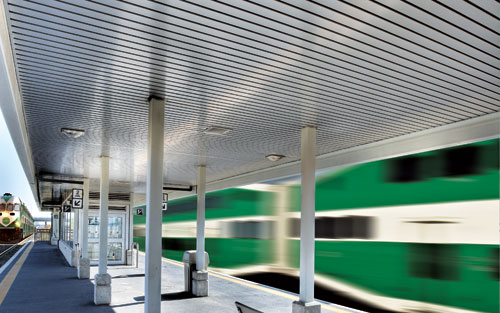 |
Interior and exterior linear metal ceilings provide visual continuity and performance at a Go Transit Station in Brampton, Ontario, Canada. Consulting engineer: R.J. Burnside & Associates Ltd. Photo by Bochsler Creative Solutions, Burlington, ON; courtesy of Chicago Metallic |
Metal Roofing and Panel Systems
Metal roofing and panel systems are proven technologies that keep evolving over time in response to technology, codes, standards, and industry demand. Metal roofing systems are low maintenance, durable, and able to resist wind, fire, hail, and UV rays. Metal roofs are available in colors compatible with cool roofs. A cool roof refers to an outer layer or exterior surface of a roof that has high solar reflectance and reduces heat gain into a building.
Insulated metal panels are a form of continuous insulation, with rigid urethane foam sandwiched between two sheets of coated metal. IMPs serve as walls, ceilings, and roofs for commercial and industrial buildings, in new and retrofit construction. Suitable applications include schools, hospitals, religious, correctional, manufacturing and maintenance facilities, office buildings, aircraft hangars, distribution warehouses, and mechanical penthouses.
IMP systems provide many of the same benefits found with other metal wall and roof systems, plus some unique benefits. IMPs are composite, factory-fabricated units that attach directly to the supporting structure. The panels are factory-insulated, single-element panels with factory-applied coatings. They are lightweight, easy to install, with a one-piece construction process for faster building completion, all year round in any kind of weather, resulting in reduced construction and interim financing costs. There is reduced risk to system integrity since IMPs have few field-assembled components with no multiple installation steps.
INSULATED METAL Pacific Plaza The Pacific Plaza building was a four-story, crumbling parking garage. The $35-million renovation features two new floors of commercial space and a green roof. More than 26,000 square feet of IMPs clad the renovated office building and parking structure, for a monolithic, polished look. Panels finished in weathered zinc were installed horizontally. IMPs interface with a cement composite façade system cladding the exterior walls on the parking structure. |
Photo courtesy of Metl-Span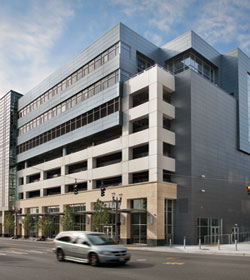 |
Solar Power Arrays On Metal Roofs
According to the National Renewable Energy Laboratory, more energy from the sun falls on the earth in one hour than is used in one year. Solar cells, or photovoltaic (PV) cells, convert sunlight directly into electricity. Single solar cells combine to create a solar module. Solar modules combine to create a solar array, which is the PV system used to generate power.
Solar arrays are an ecological resource with a low carbon footprint that harnesses the sun's renewable energy. They will produce 85 percent of rated energy production 20 years after installation. Available in a variety of technologies including modules of polycrystalline and thin film, arrays are reliable, producing energy anywhere the sun shines at a fixed and known cost that won't fluctuate as fuel costs and utility rates escalate.
Photovoltaic SystemsCombining metal roofing with PV systems provides owners with several benefits. Solar modules can be installed on a metal roofing system with no penetrations through the roof, allowing the metal roofing warranty to remain intact. PV system efficiency typically improves with cool metal roof installations, by increasing the energy output of the solar modules.
Nearly 80 percent of PV installations occur on existing construction. The service life of a metal roofing system is compatible with that of a solar array. PV systems typically last at least 25 years. Rather than install a roofing system that will only last 15-20 years, requiring costly downtime, removal and reinstallation of the solar array during replacement of the roofing, choosing a metal roof that will last 40 years or more will allow the solar array to stay in place during its service life. This results in a savings on labor to remove and reinstall the array, savings on roof replacement, and avoids interruption of electrical generation and potential roof leaks.
Solar Array InstallationBefore installing a solar array on any roof, a registered professional engineer should be consulted to determine if the roof can support additional loads. The best direction for the solar array to face is south, though roof areas facing east or west can also be used.
Usually, about 75 percent of a roof area can be utilized for the solar array, unless there are obstacles on the roof, such as skylights or rooftop equipment. Shading of the solar array should also be investigated. Solar modules cannot be installed to the roof edge. Adequate distance must be left at the roof edges for roof access.
Standing Seam Metal Roof SystemsA standing seam refers to the side joints of roof panels that are arranged in a vertical position above the roof line. A standing seam roof (SSR) system is one in which the side laps between the roof panels are arranged in a vertical position above the roof line. The roof panel system is secured to the roof substructure by means of concealed clips attached with screws to the substructure, except that through fasteners may be used at limited locations, such as ends of panels and at roof penetrations. Standing seam metal roof systems typically use concealed fastened systems, to hold panels firmly in place and accommodate thermal movement.
Standing seam metal roof systems are durable and weathertight. Vertical leg and trapezoidal are two popular types of structural standing seam metal roof systems. Vertical leg structural standing seam metal roof systems maintain UL uplift ratings, assuring reliable performance, while providing flexibility for design challenges.
Trapezoidal structural standing seam metal roof systems are available in snap-together and field-seamed systems, which are designed for strength, durability and weatherability. The standing seams are 3 inches above the lowest part of the panel, well above the water level as it flows off the roof. The rake/gable at both ends of each roof system finish with a 3-inch-high standing seam, avoiding the necessity of finishing in the low, flat part of the panel where the greatest possibilities for leaks occur in many other systems.
SSR panels can be installed before or after the exterior walls are in place. All trim is attached after the roof is installed. With a recommended minimum slope of ¼:12, these standing seam metal roof systems can be used on all types of construction, including metal, masonry or wood, for new construction or retrofit.
RatingsSome manufactured standing seam metal roof systems carry the UL Fire Resistance and Wind Uplift (UL 90) ratings covering various roof designs. Testing certifications should be verified for each specification and building code.
Special clips allow for thermal roof expansion and contraction during extreme temperatures. Trim should be weathertight, to secure against wind and rain. Factory-applied sealant in the panel sidelap ensures a weathertight lap.
As with all standing seam metal roof systems, sound attenuation (such as blanket insulation) is required between the panel and the substructure to prevent “roof rumble” during windy conditions. Some composite roof systems may require additional acoustical consideration to ensure that thermal vibration noises are isolated from the building's interior.
Insulated Metal Panels
Buildings are more comfortable and energy efficient with the right insulation. In the winter, heat flows out; in the summer, heat flows in. A properly insulated structure reduces the heat flow, so less energy is used for heating in the winter and cooling in the summer, resulting in cost savings. To create a wall with high thermal performance, air leakage, infiltration, thermal bridging, insulation, condensation, and fire protection must be controlled.
Core Insulation Components
Insulated metal panels consist of rigid urethane foam sandwiched between two sheets of coated metal, molded in different styles and sizes. Steel panel facings create a vapor barrier, and the skins are resistant to abuse. Polyurethane and polyisocyanurate have similar insulating properties for compressive, tensile and shear strength, and foam density. Steel panel facings contain more than 30 percent recycled content, while foam cores contain 7 percent pre-consumer recycled content. Panels can be disassembled, moved, and reused.
IMPs are available in many finishes and coatings, prefinished on the interior and exterior faces. Coatings provide protection against UV rays, corrosion, humidity, acid rain, chemicals, and pollutants; resistance to chalking, fading, chipping and dirt, and offer gloss retention.
Cool roofs help mitigate global warming and reduce urban heat islands and smog. They reflect (solar reflectance) and radiate (thermal emittance) the sun's heat away from a building. Insulated metal roof panels with a white exterior skin meet the definition of cool roofing for low-slope roofing under the 2005 California Energy Code.
Panel Description and InstallationInsulated metal panels offer installation savings through single element panels and fewer side joints, resulting in weathertight performance. They are self-contained units of roof weather membrane, roof insulation, and liner/decking. Engineered end laps create long runs from roof ridges to eaves. The panel ends are supported by the roof structure.
Architectural Wall PanelsArchitectural wall panels provide a flush appearance, and combine well with window systems. High-performance continuous insulation panels provide air, water, thermal, and vapor protection in a single-panel component without thermal bridges. They are quick and easy to install behind any type of external cladding, such as a single-skin metal panel. The panels are separated from the building interior by an approved thermal barrier. IMPs are tested and carry ratings for fire, structural performance, thermal transmittance, foam core properties, water penetration, and air pressure differential.
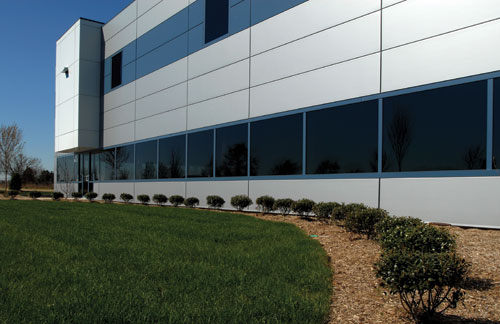 |
ProCLAD, Inc.’s new corporate headquarters in Indianapolis, Indiana, utilized approximately 11,000 square feet of flat insulated metal wall panels finished in silver and blue, accented with horizontal reveals. The 15,000-square-foot building incorporates a window system featuring a flush frame that integrates with the horizontal wall panels. Architect: Lamson and Condon Architecture and Interior Design. Photo courtesy of Metl-Span |
Thermal Performance
IMPs can reduce operating costs by lowering building energy consumption. They are installed completely outboard of a structure. In this way, consistent R-values are maintained across the entire wall and roof areas. The R-value refers to resistance in heat flow and is a measure of thermal resistance, especially regarding insulation. Increasing the thickness of an insulating layer increases the thermal resistance. The higher the R-value, the greater the insulating power.
Insulated metal panels have high insulation values with built-in thermal breaks, impermeable faces and membranes, and concealed fastener systems with vapor, air and water barriers. Panel selection should be based on the thickness needed to meet required thermal value and structural needs. Thermal values should be specified based on local codes, usage, and occupancy. IMPs have a foam core that provides R-values generally ranging from 15 to 48 as tested with ASTM C1363 at 75 F, in thicknesses from 2 to 6 inches for wall systems, and R-values ranging from 10 to 48 for roof systems.
RatingsPanel production must formulate a foam system with the right balance of the following properties: shear, tensile and compressive strength; humid, heat and cold aging; density, flash and ignition properties.
Structural load capacity should be tested for positive and negative wind loads by an independent testing agency. The panel manufacturer should verify testing data to ensure that panel structural capacity meets project requirements. Coatings are tested and rated for various conditions, including color change, chalk resistance, specular gloss, humidity, salt spray, impact and abrasion resistance.
Design BenefitsInsulated metal panels offer flexibility and design options through a wide range of colors, finishes, and textures. Flat, profiled, curved and formed panels may be installed horizontally or vertically. A flush appearance can be achieved when panels are attached with concealed clips and fasteners in the side joint, often ideal for high-profile applications.
Insulated Metal Panels Case Studies
| 1. Hope Lake Lodge Cortland, New York LEED Silver Architect: RBA Group |
||
A new indoor water park at the Greek Peak Ski Center transformed the winter resort into a year-round destination. The temperature inside the 28,000-square-foot facility is maintained at 80-84 degrees F even during the most frigid months. Approximately 60,000 square feet of insulated metal panels were used to clad the roof and walls. A steel structure enabled the use of large clear spans of IMPs to house the water park features and provides high thermal efficiency. To address the inherent high humidity and chlorine-laden atmosphere, steel members were galvanized and powder coated for corrosion-resistance. |
| 2. Aerzen USA Coatesville, Pennsylvania LEED Gold Architect: Re: Vision Architecture |
||
The Aerzen USA plant is an environmentally friendly facility that manufactures industrial equipment. Approximately 54,000 square feet of insulated metal panels were used on the wall and roof. A lightly corrugated panel profile on both faces ensures symmetry from the outside to inside. IMPs usually used for freezer applications quadrupled the insulation value. |
Metal Ceiling Systems
Along with metal ceiling finishes, manufacturers offer a variety of sizes and shapes where designers want the ceiling to express a module or make a statement. These designs can incorporate acoustical absorption. While a standard metal ceiling offers little acoustical value, perforating the panels and adding a backer material can typically provide acoustical absorption, or noise reduction coefficient (NRC) of .65. Adding fiberglass backing behind the ceiling typically provides an NRC of .90. Metal ceilings can provide increased security to a space where ceiling access must be discouraged or prevented. The security levels can be moderate for supervised spaces, or greater for unsupervised prison occupancies.
 |
A 20-foot-high suspended, segmented, vaulted custom ceiling system crowns the space at Winthrop University’s Vivian Moore Carroll Hall, in Rock Hill, South Carolina. Architect: FWA Group. Photo by Dustin Shores Photography, Charlotte, NC; courtesy of Chicago Metallic |
Linear Metal Ceilings
Developed in the 1960s to add additional design elements to spaces, linear metal ceilings feature continuous lines in various styles and finishes. Linear systems can be flat or curved by using different suspension methods, inside or outside.
Panels are nominally 4 inches wide or wider and available in round or square edges. Finishes can be painted, such as baked enamel, powder coat and metallic; plated, such as brass and chrome; or woodgrain, from paint, polymers and veneers.
The spaces between the panels may be left open for acoustical or air movement requirements, or closed with separate filler strips or integral filler strips. They can be used as an open plenum system, such as in large public waiting areas, or may be solid or perforated to add acoustical absorption.
Linear metal ceilings have been used extensively on exterior and interior applications. They allow designers options for visual design continuity from exterior outdoor vestibules, entryways, and soffits to interior spaces. Exterior ceilings are engineered for wind load bracing. Local codes determine the necessary degree of wind resistance. Linear metal ceilings can accommodate positive and negative pressures while integrating building services such as lighting, air diffusion, and audio accessories.
Metal Panel CeilingsLay-in metal panels are durable, available in different finishes, standard and custom sizes, can be perforated for acoustical absorption, and can have reveal edges. They can also be formed into pods or clouds for unique design elements. Perforation patterns typically include borders to prevent bending at a perforation.
Another variation, snap-up metal panels, offers tight joints, no visible grid, and provides security, to discourage or prevent unauthorized access to ceiling plenums. The snap-up system can be also perforated for acoustics and used in various configurations. Snap-up panel systems can be used in exterior applications, with proper bracing.
Design Issues
Building codes, acoustics, corrosion, and materials must be reviewed when specifying metal ceilings.
Codes include fire, seismic, and wind load requirements:
- Fire ratings: Metal ceilings are typically characterized by a Class A fire rating (ASTM E 84), but are not included in any UL time rated designs.
- Seismic: The International Building Codes addresses seismic restraints for ceiling suspension.
- Wind load: Exterior wind load requirements are dictated by local code officials, typically using UL: 580 and ASTM C636-04.
Acoustics: Solid metal panels without perforations offer no acoustical absorption. Perforated panels can offer acoustical absorption, expressed as the noise reduction coefficient. Perforated panels with a backer material typically yield a 65 NRC, while perforated panels with polybagged insulation can yield a 90 NRC.
Corrosion is a factor when considering materials. The site environment and cleaning regimen must be addressed when choosing base materials for these systems.
Materials: Steel is only suitable for interior use and must be painted or clear coated to reduce corrosion. Recycled content will always be minimum 25 percent. Aluminum is suitable for interior and exterior use. Painted aluminum panels contain almost 100 percent recycled material. Aluminum panels that are anodized must be made from 100 percent bauxite, or aluminum ore. This includes brass and chrome coat finishes.
Metal Ceiling Systems Case Studies
| 1. Buffalo Sabres Team Dressing Room First Niagara Center, Buffalo, New York Architect: Cannon Design |
||
The Buffalo Sabres ice hockey team dressing room is an oval shape that reflects the contours of the arena. An elliptical metal ceiling conveys a feeling of silver blades on cold ice. The ceiling glows with a moiré effect of diffused points of light. At the center of the room is the Buffalo Sabres logo, designed as a lantern shining over the players as they prepare to take the ice. An accelerated project schedule required delivering a $9-million, full-facility renovation in less than five months, including this team space. The Sabres wanted to express their identity, inspire current players and present an impressive image to recruits. The design solution is an oval shaped space, instead of the traditional rectangular locker and dressing room. The oval has no awkward points, no players in corners. A strategy wall is along one side, and the circular design allows every player to see it. The glowing, circular ceiling is highlighted by the lantern logo at the center. The vision for a glowing ceiling started with the illuminated logo lantern. Translucent to opaque ceiling panels were considered, along with perforated panels to create the look of light radiating from the logo. The final design employs metal panels to capture the cool feeling of ice, with a sleek, finished look, like steel skate blades. A custom-fabricated linear metal ceiling system allows easy access to fluorescent lighting fixtures above the ceiling panels. Completed in time for the start of the NHL season, the team locker room received rave reviews. |
| 2. Bradley Central High School Fine Arts Center Cleveland, Tennessee Architect: KBJM Architects |
||
In this new 600-seat high school auditorium, the audience can view young talent and a creative ceiling design, where curved clouds float overhead. The school district wanted the $3.3-million project completed within 12 months, opening in 2011. Using the space above the audience was an integral part of the curved metal ceiling design, to evoke dynamic movement. A two-directional grid suspension system with flexible metal panels in metallic gold added to the drama, and complemented the warm interior design palette. A metal ceiling suspension system created floating ceiling sections housing acoustic panels. The sections had a stepped perimeter for visual effect and were finished with perimeter trim, to achieve a crisp appearance. The condensed schedule meant the auditorium seats needed to be installed prior to the ceiling, so scaffolding could not be erected for the ceiling installation, presenting a challenge to the team. The solution was to assemble grid sections on the ground, connect them into pods, hoist the pods up to the ceiling area using a lift, and connect them in the air. In all, five 8-foot x 25-foot pods were assembled. The curved metal ceiling system rigidity and light weight made installation possible. The project was completed on schedule in June 2011, in time for graduation day. |
| 3. Porsche of The Motor City Eastpointe, Michigan Architect: CHMP Associates |
||
Porsche promotes its product exclusivity and performance superiority at the car dealership. When an existing 1960s showroom was renovated in 2011, the goal was to create an environment that showcased the Porsche brand. In the showroom, the car is the star. Silver perforated metal ceiling panels were chosen for the showroom design, to provide a dramatic, contemporary, minimalist ambiance that matched the silver shade many owners choose when they customize their new Porsche. Perforated ceiling panels achieved acoustic goals for the space. Installed in a 24-inch by 24-inch grid pattern, the panels concealed the old grid system, which was retained, saving time and money. |
Metals and Sustainability
The Leadership in Energy and Environmental Design (LEED) green building certification program, developed by the U.S. Green Building Council (USGBC), is a point-based system. LEED credit requirements cover the performance of materials in aggregate, not individual product performance.
Metals are highly sustainable and recyclable. Applicable LEED categories, credits and points vary by product and manufacturer. Most building product manufacturers provide detailed information on their websites describing LEED credits and points associated with their products and materials. LEED credits and points are available in the following categories:
- Sustainable Sites (SS)
- Water Efficiency (WE)
- Energy and Atmosphere (EA)
- Materials and Resources (MR)
- Indoor Environmental Quality (IEQ)
- Innovation in Design (ID)
- Regional Priority
A summary of metal sustainability features includes:
- Aluminum composite panels can contribute to LEED points in the Innovation in Design category, in the Materials and Resources section. Aluminum composite panels are a composite material manufactured using coil-coated aluminum over a polyethylene core. The aluminum skins are 90 percent post-industrial recycled material.
- Metal roofs are virtually 100 percent recyclable, allowing for reduced landfill mass, and are typically comprised of 25 to 35 percent post-consumer recycled steel.
- Insulated metal panels may help satisfy requirements for these LEED categories: Sustainable Sites, Water Efficiency, Energy and Atmosphere, Materials and Resources, Indoor Environmental Quality, Innovation in Design.
- Metal ceilings, including aluminum, are 100 percent recyclable at the end of their useful life. The recycled content range for both post-consumer and post-industrial is 25-90 percent.
Conclusion
Metal materials and products provide owners and occupants with high-performance building envelopes and interior environments which are safe, sustainable, and cost-efficient to operate.
Innovative research and ongoing development of proven building industry technologies has led to titanium dioxide coil-coated aluminum architectural panels which self-clean buildings while reducing air pollutants and cleaning costs; and aluminum ceiling systems that protect building occupants from fire, seismic, and wind load forces. Insulated metal roof and wall panels provide air, water, thermal, and vapor protection in a single component and lower year-round building energy consumption. Finally, these multi-functional metal products are engineered to meet rigorous U.S. performance standards, which cannot be said of all imported metal building products.

